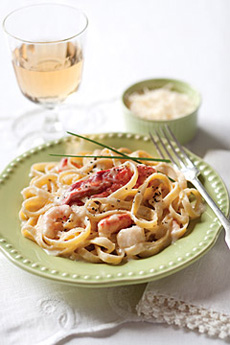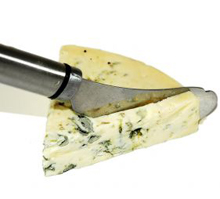

A Fettuccine Alfredo recipe topped with lobster, shrimp and scallops. Photo courtesy MackenzieLtd.com.
|
KAREN HOCHMAN is Editorial Director of THE NIBBLE.
|
|
April 2007
Last Updated February 2012
|
 |
Putney Pasta Recipes
Page 3: Fettuccine Alfredo (The Correct Italian Spelling)
This is Page 3 of a four-page article. Click on the black links below to visit other pages.
Here are two recipes that show how versatile Putney Pasta is. The first is a ravioli “Alfredo” that’s made even more glamorous than the standard Fettuccine Alfredo with a layering of blue cheese, walnuts and Port. The second transforms the Butternut Squash Ravioli into a dessert. While it sounds perfect for fall, there’s no need to stereotype food: Squash, pears, apples and walnuts taste delicious anytime.
A spelling note: The Italian word is fettuccine. “Fettuccini” is an Americanization—just as Americans decided to spell “salame,” the Italian word, as “salami.”
Ravioli Alfredo or Fettuccine Alfredo Recipe—And Who Is “Alfredo?”
You can make this popular recipe extra-special with ravioli, or make it with standard fettuccine. The blue cheese, Port and walnuts will make the fettuccine version special enough.
The History Of Fettuccine Alfredo
For Fettuccine all’Alfredo, the fettuccine is cooked in the same skillet in which the sauce is made. The original recipe was created in 1914 by Alfredo Di Lelio, owner of Alfredo alla Scrofa restaurant in Rome. In a restaurant setting, the hot fettuccine are tossed with the cheese, butter and cream and, as the cheese melts, it unites with the butter and cream to form a coating or “sauce” for the pasta.
In Italy, “Alfredo sauce” and “Fettuccine Alfredo” are not common terms. Long before Alfredo created his recipe, Italians enjoyed fettuccine al burro, fettuccine with butter, or fettuccine al burro e panna, with butter and cream, both served, of course, with grated cheese. Alfredo just tweaked the recipe slightly. When butter was added both before and after fettuccine was put in the serving bowl for tossing, it was known as doppio burro, double butter.
Di Lelio doubled the amount of butter in the bowl before the fettuccine was added, creating a triplo burro, triple butter, recipe: more butter made more of a sauce. The chef created the dish to entice his pregnant wife, who had lost her appetite. He served it with egg fettuccine, hoping that the “nutritious dish” would do the trick. Today, we know that a typical serving of the “nutritious dish” has 455 calories, 38g of fat, 291mg of sodium and 143g of cholesterol. But for people who love rich, creamy food, it hits the spot!
Fettuccine Alfredo Recipe With A Twist
The twist, crumbled blue cheese, is optional.
Ingredients
 1 one-pound package cheese ravioli 1 one-pound package cheese ravioli
or fettuccine pasta - Alfredo Sauce* (purchase or make your own
with the recipe below)
- 2 tablespoons crumbled blue cheese
(optional)
- 6 ounces white Port wine (or substitute
sherry or other sweet wine)
- 1 tablespoon walnut pieces
- 1 tablespoon parsley, chopped
Preparation
In a saucepan, bring Port to a boil and let it reduce by 50%. Lower the heat; add Alfredo sauce and blue cheese, stirring often. Cook ravioli according to package directions. Drain pasta and transfer to a bowl. Gently toss with sauce and garnish with chopped parsley and walnuts. Serves 4 as an entrée or 6 as a first course.
Alfredo Sauce Recipe
Alfredo Sauce is a butter and cream sauce flavored with Parmesan cheese. A good-quality cheese is paramount. This recipe serves four.
Ingredients
- 8 tablespoons (1 stick) unsalted butter (at room temperature)
- 1 cup heavy cream, slightly whipped.
- 1/2 cup freshly-grated Parmigiano-Reggiano cheese
- 1/4 teaspoon salt
- Freshly-ground white pepper to taste*
*White pepper—the fruit of the pepper with the black outer skin removed—is used in the light-colored sauces of European cuisine because it was felt that black specks sullied the light sauce. This is old thinking. Feel free to use black pepper.
Preparation
- Melt butter in a saucepan and whisk in cream.
- Whisk or stir continuously with a wooden spoon until the mixture is hot and slightly reduced.
- Slowly add cheese until thoroughly blended. Add 1/4 teaspoon salt and white pepper to taste.
Continue To Page 4: Dessert Ravioli Recipe
Go To The Article Index Above
Recipe © Putney Pasta. Other material
Lifestyle Direct, Inc. All rights reserved. Images are the copyright of their individual owners.

|